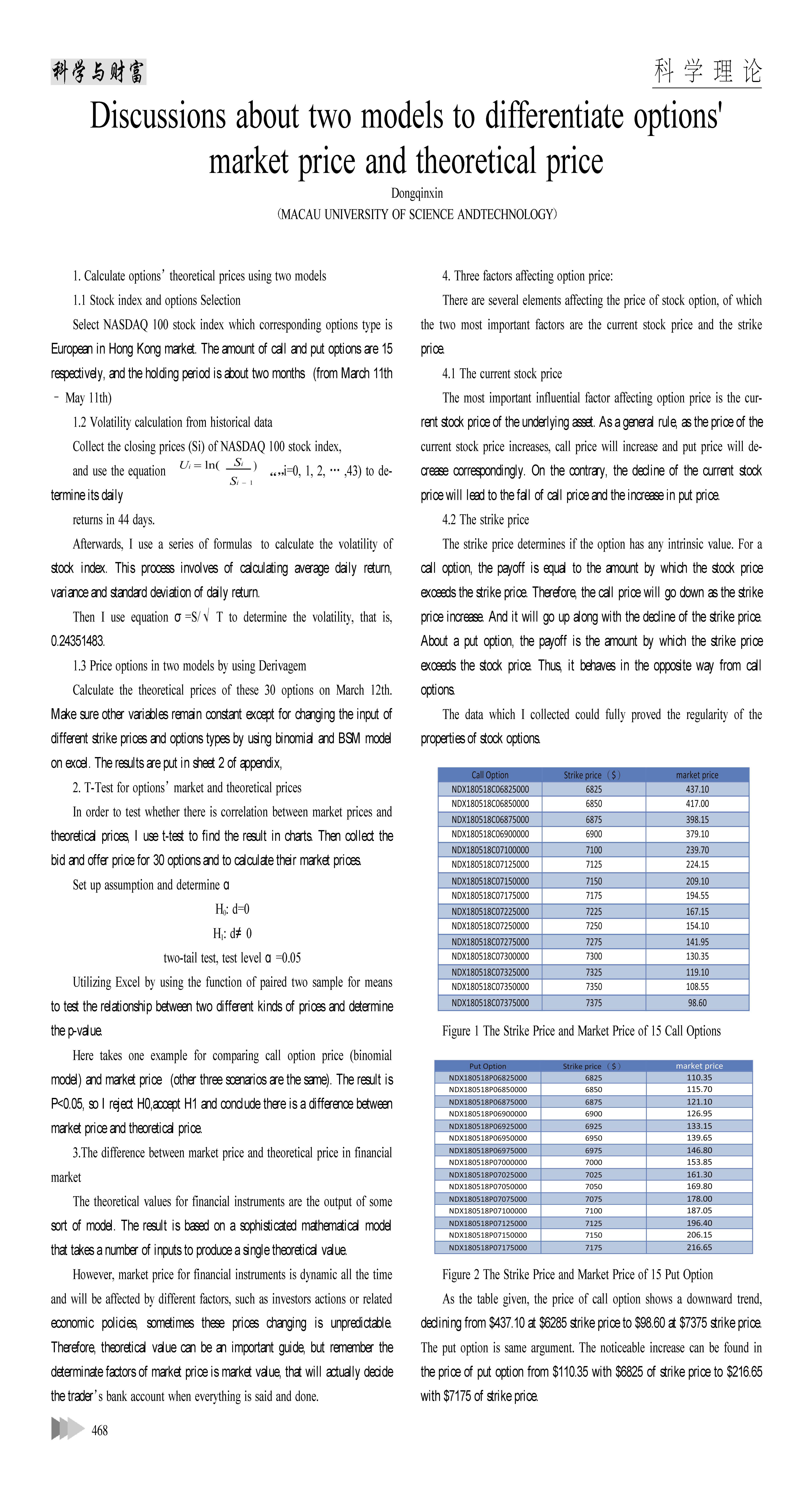Discussions about two models to differentiate options
2018-10-19Dongqinxin
Dongqinxin


1. Calculate options theoretical prices using two models
1.1 Stock index and options Selection
Select NASDAQ 100 stock index which corresponding options type is European in Hong Kong market. The amount of call and put options are 15 respectively, and the holding period is about two months (from March 11th – May 11th)
1.2 Volatility calculation from historical data
Collect the closing prices (Si) of NASDAQ 100 stock index,
and use the equation ,(i=0, 1, 2, … ,43) to determine its daily
returns in 44 days.
Afterwards, I use a series of formulas to calculate the volatility of stock index. This process involves of calculating average daily return, variance and standard deviation of daily return.
Then I use equation σ=S/√T to determine the volatility, that is, 0.24351483.
1.3 Price options in two models by using Derivagem
Calculate the theoretical prices of these 30 options on March 12th. Make sure other variables remain constant except for changing the input of different strike prices and options types by using binomial and BSM model on excel. The results are put in sheet 2 of appendix,
2. T-Test for options market and theoretical prices
In order to test whether there is correlation between market prices and theoretical prices, I use t-test to find the result in charts. Then collect the bid and offer price for 30 options and to calculate their market prices.
Set up assumption and determine ɑ
H0: d=0
H1: d≠0
two-tail test, test level ɑ=0.05
Utilizing Excel by using the function of paired two sample for means to test the relationship between two different kinds of prices and determine the p-value.
Here takes one example for comparing call option price (binomial model) and market price (other three scenarios are the same). The result is P<0.05, so I reject H0,accept H1 and conclude there is a difference between market price and theoretical price.
3.The difference between market price and theoretical price in financial market
The theoretical values for financial instruments are the output of some sort of model. The result is based on a sophisticated mathematical model that takes a number of inputs to produce a single theoretical value.
However, market price for financial instruments is dynamic all the time and will be affected by different factors, such as investors actions or related economic policies, sometimes these prices changing is unpredictable. Therefore, theoretical value can be an important guide, but remember the determinate factors of market price is market value, that will actually decide the traders bank account when everything is said and done.
4. Three factors affecting option price:
There are several elements affecting the price of stock option, of which the two most important factors are the current stock price and the strike price.
4.1 The current stock price
The most important influential factor affecting option price is the current stock price of the underlying asset. As a general rule, as the price of the current stock price increases, call price will increase and put price will decrease correspondingly. On the contrary, the decline of the current stock price will lead to the fall of call price and the increase in put price.
4.2 The strike price
The strike price determines if the option has any intrinsic value. For a call option, the payoff is equal to the amount by which the stock price exceeds the strike price. Therefore, the call price will go down as the strike price increase. And it will go up along with the decline of the strike price. About a put option, the payoff is the amount by which the strike price exceeds the stock price. Thus, it behaves in the opposite way from call options.
The data which I collected could fully proved the regularity of the properties of stock options.
As the table given, the price of call option shows a downward trend, declining from $437.10 at $6285 strike price to $98.60 at $7375 strike price. The put option is same argument. The noticeable increase can be found in the price of put option from $110.35 with $6825 of strike price to $216.65 with $7175 of strike price.
5. Influential factors of theoretical price
Both Binomial and BSM models are idealized models that are valid only under some certain assumptions, including no transaction cost, constant return rate of riskless asset and no arbitrage.
For pricing stock index options, there are 6 determinant factors in the models: stock index price, strike price, option type, time to expiration, risk-free rates and future volatility.
This table above how call and put options respond to changes in these variables, and then excluding the ideal factors and certain factors, I only discuss 4 elements except the rates whose influences can be ignored.
1) Stock index price
Conceptually in the two models, if S0 increases, the price of a call will increase and the price of the put will decrease with all other factors constant. However, the other factors rarely stay constant in real market. If volatility decreases a lot, for example, the price of the call option will be down even though the stock index price is up.
2) Strike price
According the requirements defined in the models, lower strike calls and higher strike puts must be more valuable with all other factors the same. Therefore, falling strike prices are beneficial for call option holders and rising strike prices are good for put holders.
3) Time to expiration
For either call or put options, as the time to expiration increases the value of the option increases, and the time to expiration gets closer, the value of the option begins to decrease.
4) Future volatility
In the model pricing process, what I really need to know is the future volatility of the stock and not the historic volatility, which can be estimated, however, by using closed prices over the most recent dates. I decide to determine the price in March 12th and estimate that its future volatility is to be calculated. Its the future volatility of the stock that affects the price of an option mostly, and, both Binomial and Black-Scholes Model are complex forms of put-call parity with volatility as the key ingredient. And because the asymmetrical payoff structures of options, an increase in volatility will increase in call and put prices.
Conclusion
Based on the results IA prominent investor who holds a large stake in the Burton Tool Company has recently claimed that the company is mismanaged, citing as evidence the company's failure to slow down production in response to a recent rise in its inventory of finished products. found, I learned that theoretical price has a significant difference with market price with , since theoretical price is calculated by idealized models that are valid only under some certain assumptions, including no transaction cost, constant return rate of riskless asset and no arbitrage. But obviously, this situation will never happen in reality, so I can only use these prices to forecast very few market future trend. Many other factors are necessary to help arbitrage, like maturity, risk-free rate, globalization market and so forth. Investors always need to remember that “Opportunity and risk are always hand in hand in the stock market” .
Reference
[1]http://www.volcube.com/resources/options-articles/the-difference-between-
theoretical-and-market-value/
[2]https://theoptionprophet.com/blog/7-factors-that-affect-an-option-s-price
[3]http://www.optionsuniversity.com/blog/options-universitys-options-101-part-69
董沁心(1997.07-),女,漢族,山东聊城人,澳门科技大学学生
